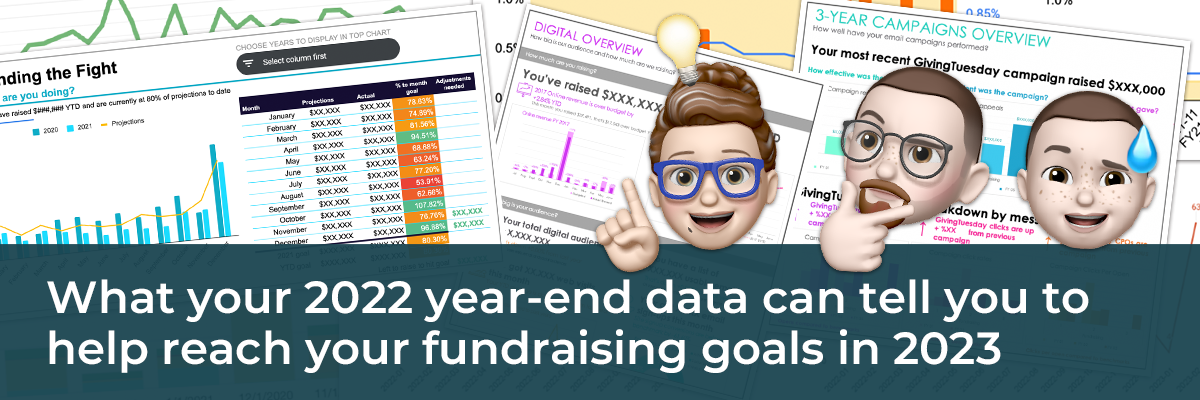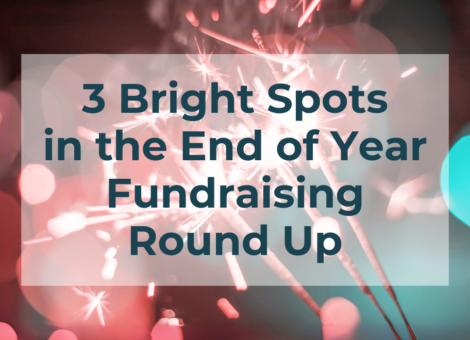For many nonprofit fundraisers, the calendar reminder you set yourself to start planning for year-end season can feel like an abrupt (and for some, premature) end to a leisurely summer. It might take a beat or two to gear up and start to strategize (and, of course, review last year’s data!) – but it doesn’t have to be strenuous!
Even better, the Freshies’ incredible team of data nerds has analyzed our clients’ 2022 year-end data and pored over insights provided across the industry from valuable resources like the Fundraising Effectiveness Project. And today, they’re sharing some findings that will help you take action right now to inspire your digital audiences – and prime them to give generously when it matters most.
Here are three actionable and data-driven tips that you can start right now to help drive a successful fundraising season at year-end, courtesy of our intrepid data team.
1. Keep your email frequency and cadence up (all year)
It’s no secret that year-end fundraising demands that you pull out all of the stops and then some to grow your fundraising response: More channels! More appeals! Another match!
But the onslaught of Black Friday and holiday sales emails and ads we witnessed last year upped the ante of unwanted competition in donors’ inboxes and newsfeeds, especially on Giving Tuesday. We had already planned for higher frequencies in Giving Tuesday campaigns to help mitigate declining response rates (because when response is down, you need to lean in and ask more to hit your goals). And both among our clients and across the industry, we saw clearly that nonprofits who added additional emails to their existing campaigns raised more money.
But our data team also saw that clients whose overall email frequency in 2022 had decreased struggled to drive giving at the end of the year, showing how important it can be to keep up a strong cadence over the course of the year.
We can’t know what the fundraising climate will look like this November and December, but we know this: The sooner you make a concerted effort to boost your nonprofit’s email frequency and cadence, the more successful your fundraising is likely to be at the end of the year, when nonprofits raise an average of one-fifth their annual revenue.
2. Build a strong case for giving in your messaging
Well before Thanksgiving, there were already signs of uncertainty. Email response rates and lower-level and unsolicited web giving began to soften amid broader economic concerns, putting more pressure on nonprofit fundraisers to hone in on why their organizations deserved your donations.
And in their 2022 year-end analysis, our data team saw that play out among our clients, too: Those that had more well-crafted messages were much better able to make it through in an environment that included a lot of hesitancy to give.
So if you can hone in now – well before the frenzy begins – on the most compelling reason to give to your organization, you will be in a better position at year-end for two reasons: You will have stronger, more battle-tested messaging on hand and you will have done more to engage your audience over time, priming them to give at year-end.
3. Invest in Google ads – and start learning what drives performance now
Investing in digital ads as another channel in your digital program has a measurable impact on list growth and fundraising results, particularly during the end of the year. Many nonprofits are already doing this, but in terms of your return on investment, the landscape shifted notably last year – and our data team saw this play out during their year-end analysis.
Once upon a time, Facebook ads were a sure shot for nonprofit fundraising. But Facebook has been one of the hardest-hit vendors by the privacy and cookie changes that have been sweeping the internet. Google search ads, meanwhile, have seen a steady increase in performance, especially for donation asks. One of the advantages of Google search ads is that your potential supporters are already searching for keywords that relate to your work. So instead of increasingly sketchy targeting options with Facebook, you get concrete, first-person indications that they’re interested in your nonprofit’s areas of focus.
Two noteworthy examples from our clients’ 2022 year-end digital ads campaigns: One organization we work with got a return on ad spend (ROAS) of almost $6 on their year-end Google search ad spend – by far outperforming the $3.72 nonprofit benchmark for search ads. Google search ads helped another client raise more than 10 percent of its overall year-end online revenue.
The TLDR: Now is the time to boost your Google ads budget. The sooner you do, the sooner you’ll learn what works best for your nonprofit and optimize (all while earning revenue) throughout the year. So when crunch time comes around in late December, your donors and potential donors will already be primed for the message – and ready to donate.



